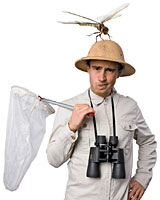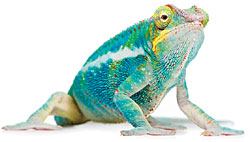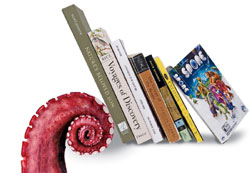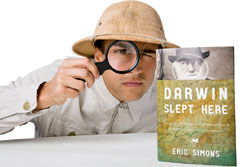sierraclub.org - sierra magazine - january/february 2009 - mixed media


Mixed Media
Happily following in the footsteps of John Muir and Charles Darwin
 Surrounded by nature: author Eric Simons.
Surrounded by nature: author Eric Simons.On a hike last fall on the John Muir Trail, I came across a 64-year-old Englishman sitting on a log, eating chips and slapping at mosquitoes. After two weeks in the High Sierra wilderness, Ivan had a few things to say about the naturalist whose eponymous trail he'd been wheezing up and down. "He was impressive, Muir," Ivan said, "although he was completely mad." Then he thought for a minute and added, "All Scotsmen are, of course."
In California's national parks, at least, you can't escape the heroic mad Scotsman. Muir's prints--finger, foot, even art--are everywhere. And it's not just because outdoorspeople love to celebrate moldering, long-dead naturalists (although we could certainly be accused of having a fascination with the past). Early catalogers of the outdoors, Muir among them, defy nature and stay fresh in our collective memories. Two recent books on the Sierra Club's founder explain why.
Donald Worster's comprehensive biography, A Passion for Nature (Oxford University Press, 2008), opens with what seems a counter to many criticisms of modern environmentalism: a sketch of Muir on the trail, in conversation with a Spanish-Irish American, and a reminder that he believed nature would bring people of all ethnicities together in the "common thrill of adventure." The book is on the musty side, but it's full of anecdotal reminders that Muir's exploits are the ones we want to chase when we're out in the woods. A passage in which he hikes through Wisconsin to escape the mental turmoil caused by the Civil War seems particularly relevant.
 In the lavishly illustrated Nature's Beloved Son (Heyday Books, 2008), Bonnie Gisel writes that Muir found a form of immortality in plants and that botany helped him make sense of the universe. Gisel also recognizes that studying Muir's specimens reconnects us with his world, which is the cool thing about dead naturalists: Their world still exists. You can hike the John Muir Trail, study the plants around you, imagine you're him, and escape contemporary worries entirely.
In the lavishly illustrated Nature's Beloved Son (Heyday Books, 2008), Bonnie Gisel writes that Muir found a form of immortality in plants and that botany helped him make sense of the universe. Gisel also recognizes that studying Muir's specimens reconnects us with his world, which is the cool thing about dead naturalists: Their world still exists. You can hike the John Muir Trail, study the plants around you, imagine you're him, and escape contemporary worries entirely.
Such is the nostalgic promise of learning about Muir, and one of the neat outcomes of the Grinnell Resurvey Project (mvz.berkeley.edu/Grinnell), an effort by the University of California at Berkeley's Museum of Vertebrate Zoology to document vertebrate diversity across California 100 years after the museum's founding director, Joseph Grinnell, did the same.
For the same idea on a different continent, there's Muir's partner in epic beard-dom, Charles Darwin. The famed British naturalist's 200th birthday is February 12, and the bicentennial is a great time to remember that Darwin helped pioneer the "gringo trail" for South American wilderness travelers. His 1830s descriptions of desolate Patagonia, wild Tierra del Fuego, and lush, tropical Brazil are the same you'd hear in hostel rooms in 2009. Darwin's accessible, amiable prose makes the Voyage of the Beagle (1839) one of the best English-language travelogues.
 Among Darwin biographies, David Quammen's The Reluctant Mr. Darwin (Atlas/Norton, 2006) stands out. Quammen's genius for language brings Darwin's personality to life, making a naturalist dead for the past five British monarchs seem like he could be a professor at a present-day university.
Among Darwin biographies, David Quammen's The Reluctant Mr. Darwin (Atlas/Norton, 2006) stands out. Quammen's genius for language brings Darwin's personality to life, making a naturalist dead for the past five British monarchs seem like he could be a professor at a present-day university.
Although Darwin's original contribution to the theory of evolution by natural selection is only a part of modern evolutionary studies, his moral dilemmas are like Muir's plants: still alive and flowering. Quammen gets that, and it's also the terrain of Adrian Desmond and James Moore, who follow up on their acclaimed biography Darwin: The Life of a Tormented Evolutionist (Warner Books, 1992) with Darwin's Sacred Cause (Houghton Mifflin, 2009), an advancement of their argument that the naturalist's entire body of evolution-related work was inspired by his hatred of slavery.
You'll even find Darwin's influence in electronic media. The PlayStation 2 game The Adventures of Darwin (D3Publisher, 2007) is a cartoonish misinterpretation of evolution and Darwin, and a bit lame too. But the newer Spore (Electronic Arts, 2008), one of the most popular PC games ever, allows players to evolve their own creature--and although the mechanism for that evolution is wrong, the game provokes players to think about the same questions asked by evolutionary biologists going back to Darwin. It's also fun to play. You're allowed to run around eating things and stealing creatures' body parts to make yourself better. It's the Grand Theft Auto of nature video games.
For subtly Darwin-inspired music, Argentine-Swedish artist Jose Gonzalez's album In Our Nature (2007) was influenced by readings of biologist Richard Dawkins and philosopher Peter Singer, and combines mellow guitar with introspective lyrics about--what else?--human nature.
Dawkins switched his attention from evolution to religion with The God Delusion (Houghton Mifflin, 2006), but with a different approach from the one found in biologist E. O. Wilson's The Creation (W. W. Norton, 2006). In a passionate book framed as a letter to a Southern Baptist pastor, Wilson calls on religious leaders to put aside their differences with scientists and join in saving life on Earth. To demonstrate that religion and science can coexist, he quotes the young, religious Darwin and the old, secular Darwin on the beauties of nature. Wilson points out that while Darwin's view of the world changed, his view of the glory of the Atlantic rainforest never did.
Which is the big reason Muir and Darwin--and Aristotle, John Audubon, Grinnell, and so many others--live on. In an age of wandering and beards, Darwin and Muir out-wandered and out-bearded most of their contemporaries. But like all great outdoor philosophers, it's the way they thought about the wilderness in which they walked, and the human relationship to it, that makes them an inspiration today.
Eric Simons is the author of Darwin Slept Here: Discovery, Adventure, and Swimming Iguanas in Charles Darwin's South America (Overlook Press, 2009).
Knowing to Ask
 "By the time Charles Darwin reached the Rio Claro, he had been away from home for more than three years. He had been living rough, sleeping half the time on a cramped ship, the other half on hard ground.... Many Chileans seemed surprised at his geological explorations. Darwin wrote: 'I found the most ready way of explaining my employment, was to ask them how it was that they themselves were not curious concerning earthquakes and volcanoes? Why some springs were hot and others cold? Why there were mountains in Chile, and not a hill in La Plata?' More than any single quote from his journal, more than any scientific discovery from the five-year voyage, this one paragraph is the reason Darwin discovered what he did and is celebrated today. He loved studying the world around him and wanted to explain what he saw. He had the courage to ask." —adapted from Darwin Slept Here by Eric Simons
"By the time Charles Darwin reached the Rio Claro, he had been away from home for more than three years. He had been living rough, sleeping half the time on a cramped ship, the other half on hard ground.... Many Chileans seemed surprised at his geological explorations. Darwin wrote: 'I found the most ready way of explaining my employment, was to ask them how it was that they themselves were not curious concerning earthquakes and volcanoes? Why some springs were hot and others cold? Why there were mountains in Chile, and not a hill in La Plata?' More than any single quote from his journal, more than any scientific discovery from the five-year voyage, this one paragraph is the reason Darwin discovered what he did and is celebrated today. He loved studying the world around him and wanted to explain what he saw. He had the courage to ask." —adapted from Darwin Slept Here by Eric Simons
Three-Minute Green
Are The Oprah Winfrey Show, The Today Show, and Robert Redford's cable TV effort, The Green, a sorry lineup of fluff-ball venues for dabbling in feel-good environmentalism, or brave new birthplaces of an eco-literate America? Journalist Simran Sethi, who got her start as an anchor for MTV News and has wowed daytime television audiences (and now hosts the Sundance Channel's The Green), makes the case that green issues are for everyone. (Before you even think of pigeonholing her, note that the MBA-toting Sethi teaches environmental communications at the University of Kansas's School of Journalism and Mass Communications and is penning a tome on environmental justice for HarperCollins.) Sierra spoke with Sethi about what it takes to "expand the conversation" about the environment from dorm lounges in college towns to living rooms across America.
What are the challenges of covering green issues on TV?
We have about two or three minutes to tell the story, and the information is new to many people in the audience. The language of broadcast journalists calls for asserting things in short sound bites without hesitation or uncertainty. But we have to grapple with the language of scientists, who don't speak with that same level of certainty.
Why do many broadcast stories gravitate to how-to topics?
It's been the goal of mainstream media outlets to empower people to feel there's something they can do toward the solution. One of the quickest ways is to shift consumer behavior. Instead of saying, "You need to stop buying stuff altogether," they'll say, "You need to buy different stuff."
What are the advantages of publishing online?
People can watch on their timetable, and it's easy to expand the conversation. On my Huffington Post blog, I can link to three studies to show how information has progressed or how we've learned more. You reach a different, smaller audience than the 6 million viewers of The Today Show.
Why was your environmental-justice program, The Good Fight, a Web-only series?
You can get away with smaller budgets and move faster. I conceived The Good Fight only a year ago; it came out of my desire to address issues that weren't being covered. We were talking about CFLs, but not about mercury contamination in farming communities. We were talking about weaning ourselves off oil, but not about the impacts of oil refineries on residents in southeast Los Angeles. I want people to understand that environmental issues are issues of civil rights. Not everyone can afford to put solar panels on their roof, but that doesn't mean they don't care about their environment.
What's your verdict on green TV?
The Sundance Channel has tried to cover all the bases: environmental justice, business, entertainment, asking what green really means. If we keep to entertainment and tips, we miss a tremendous opportunity.
Will network execs' interest in all things eco fade?
Some will do it and move on. With luck, it will become part of their DNA. Just a few years ago, you found green stories under the headings of science and health. Now the environment is its own subtopic on many news outlets.
How do your students approach the environment?
I see a strong BS detector. They're concerned about green versus greenwashing. They have a commitment to talking about the issues in a way that will bring more people on board.
That doesn't sound like MTV-watching, short-attention-span youths.
I cut my broadcast teeth at MTV News and worked on documentaries for them when I was in college. I once asked Kurt Loder, one of the founding anchors, "How do we reach these people?" He said, "You are these people!"
MTV has done a solid job on environmental issues. They recognize that they need to serve their audience. Are they going to get Cameron Diaz involved? Absolutely. If you care about fashion, I can talk to you about the implications of your traditional cotton T-shirt and the third of a pound of pesticides that went into making it. There's a way to get people involved that's not going to scare them off.
>What's your environmental vice?
I don't compost. I freeze my organic waste and give it to a friend to compost.
—interview by Reed McManus
Photos, from top: Lori Eanes (dragonfly: iStock/mrbfaust), iStock/globalp, Lori Eanes (tentacle: iStock/kativ), Lori Eanes; used with permission.